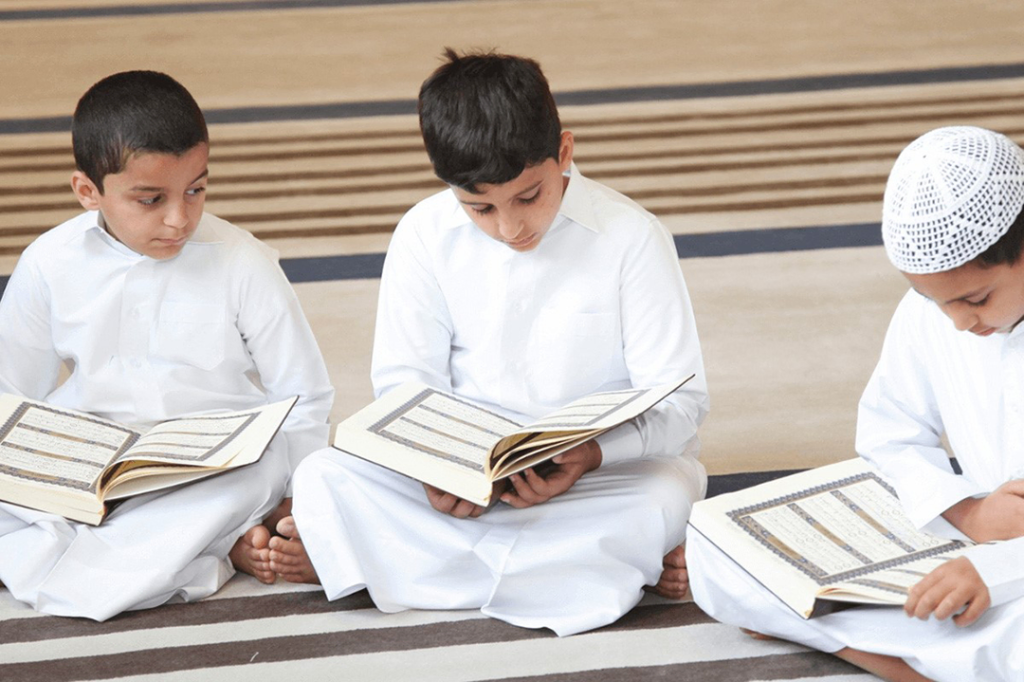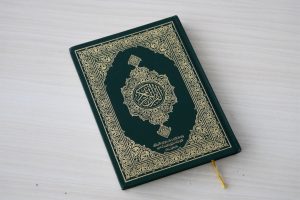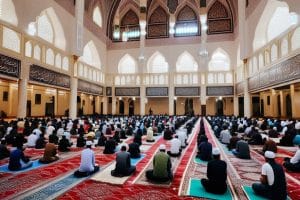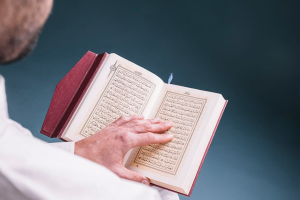I have been designated as a prophet to perfect moral standards.
Prophet Muhammad (S)
Table of Contents
ToggleModes of Quran recitation refer to the various styles and methods of orally presenting the Holy Quran. Each mode carries its own unique cadence, rhythm, and pronunciation, all of which hold deep significance in the Islamic tradition.
Understanding these modes is crucial for those seeking to explore the complex art of Quran recitation.
Importance of Proper Recitation in Quran
Connection with the Divine
Proper recitation of the Sacred Quran is vital in ensuring that the true message of Allah is conveyed accurately. Each word and letter in Quran is believed to hold immense power and significance, and as such, reciting it with proper pronunciation and Tajwid (rules of Quranic recitation) is essential.
This is because the Noble Quran was revealed in the Arabic language, and any deviation from the correct recitation can alter the meaning of the text.
Reciting the Pure Quran with proper Tajwid (Tajweed) is also important for establishing a connection with the divine. The act of reciting the Grand Quran is considered to be a form of worship and a means of seeking closeness to Allah.
By reciting the Holy Quran with devotion and sincerity, Muslims believe that they are able to strengthen their bond with their creator and receive spiritual blessings and guidance.
Moreover, recitation of the Sacred Quran is believed to have a profound impact on the heart and soul of the individual. It is believed that the words of Quran have a transformative effect on the person reciting them, purifying their heart and guiding them towards a path of righteousness.
By reciting the Glorious Quran with proper Tajwid and understanding the meanings of the verses, Muslims are able to deepen their connection with Allah and strive towards spiritual growth and self-improvement.
In addition, proper recitation of the Holy Quran is essential for the preservation of its message. Quran is a sacred text that has been passed down through generations, and it is important to ensure that it is recited accurately and preserved in its original form.
By reciting the Holy Quran with proper Tajwid (Tajweed), Muslims can ensure that the message of Allah is conveyed accurately and that the integrity of the text is maintained.
Preserving the Prophetic Tradition
One of the key aspects of Quran is its recitation. The Prophet Muhammad himself was known for his beautiful recitation of the Sacred Quran, and his followers sought to emulate his style in their own recitations.
Proper recitation of Quran is not just about reading the words correctly; it is about embodying the spirit and emotion of the text, allowing its profound meanings to resonate within the heart of the reader.
Preserving the Prophetic tradition of recitation is crucial for several reasons. Firstly, it is a way of honoring the teachings of the Prophet Muhammad and keeping his memory alive. Just as he recited the Noble Quran with reverence and devotion, so too should his followers seek to recite it in the same manner.
By preserving the Prophetic tradition of recitation, Muslims are connecting themselves to their spiritual heritage and maintaining a link to the past.
Secondly, proper recitation of the Heavenly Quran is essential for understanding its message. Quran is a deeply profound text, filled with layers of meaning and wisdom. By reciting it properly, Muslims are able to more fully grasp the nuances and subtleties of its teachings.
This facilitates a deeper connection to the Pure Quran and allows for a more profound spiritual experience.
Furthermore, reciting the Heavenly Quran properly is a form of worship in itself. Muslims believe that Quran is a sacred text that is to be treated with the utmost respect and reverence. Reciting it with sincerity and devotion is a way of showing one’s commitment to Allah and demonstrating a desire to live in accordance with His will.
Proper recitation of the Glorious Quran is a way of seeking closeness to Allah and deepening one’s faith.
Respect for the Divine Word
The Grand Quran was revealed in the Arabic language, and each word and letter in the text holds deep meaning and significance. Muslims believe that reciting Quran correctly is a way of showing respect for the word of Allah and fulfilling a duty towards the divine message.
It is believed that the recitation of the Holy Quran can bring blessings and guidance to the reciter, and proper recitation is essential to receive these blessings.
Proper recitation of the Heavenly Quran is also important for understanding its message and teachings.
The Noble Quran is not just a book of religious texts, but a guide for living a righteous and moral life. By reciting Quran with proper pronunciation and understanding its meanings, Muslims can gain insight into the teachings of Islam and live according to its principles.
Proper recitation helps in preserving the original text of Quran and ensures that its message is conveyed accurately to future generations.
Respecting the divine word of the Glorious Quran is also about maintaining a sense of awe and reverence for the book itself. Quran is considered to be a sacred text, and Muslims are taught to handle it with respect and care.
It is customary for Muslims to perform ablutions before touching the Noble Quran and to handle the book with clean hands. The Holy Quran is kept in a clean and elevated place in the home, and it is not to be placed on the ground or stepped over.
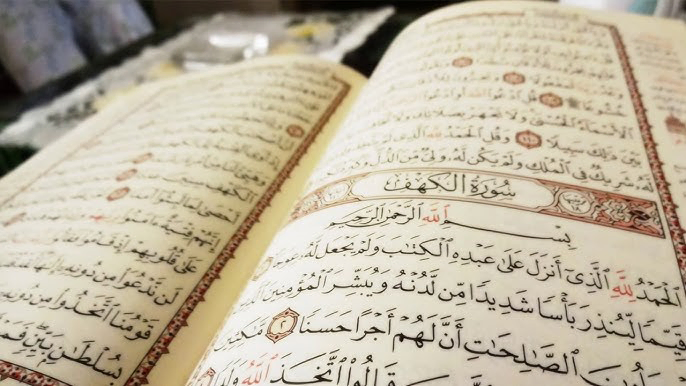
Tajwid: The Art of Quran Recitation
Phonetics and Articulation
When it comes to reciting the Sacred Quran, the importance of proper phonetics and articulation cannot be overstated.
Tajwid (Tajweed), the science of recitation of the Holy Quran, emphasizes the correct pronunciation of the Arabic letters and the proper articulation of sounds. This not only ensures the accurate recitation of Quran but also enhances the beauty and the spiritual impact of the words being recited.
In Tajwid, each letter in the Arabic alphabet is given its due importance, and the way it is pronounced can greatly affect the meaning of the word. For example, the Arabic letters “Qaf” and “Kaf” sound similar but have distinct pronunciations.
A slight mispronunciation can completely alter the meaning of the word and lead to a misunderstanding of the Quranic text. Therefore, mastering the phonetics of each letter is essential for a proper recitation of the Glorious Quran.
Furthermore, proper articulation of sounds plays a vital role in the melodious recitation of the Noble Quran.
Quran is meant to be recited with beauty and reverence, and this can only be achieved through the correct pronunciation and enunciation of the words. The rules of Tajwid outline the proper way to articulate each sound, whether it is a nasal sound, a guttural sound, or a glottal stop.
By adhering to these rules, the reciter can create a harmonious flow of words that resonate with the listener and elevate their spiritual experience.
In addition to enhancing the aesthetic appeal of the recitation, mastering phonetics and articulation in Tajwid (Tajweed) also deepens the reciter’s understanding of the Holy Quran.
By paying close attention to the pronunciation of each letter and the articulation of each sound, the reciter becomes more attuned to the nuances of the Arabic language and gains a greater appreciation for the beauty and depth of the Quranic text.
To truly excel in reciting the Sacred Quran, one must dedicate time and effort to mastering the phonetics and articulation of Tajwid. This involves practicing the pronunciation of each letter individually, learning the rules of Tajwid, and seeking guidance from a qualified teacher.
By honing their skills in phonetics and articulation, reciters can improve their recitation and connect more deeply with the divine message of Quran.
Rhythmic Chanting
It is essential for every Muslim to recite the Holy Quran in a beautiful and melodious manner to achieve a deeper spiritual connection with the words of Allah.
One of the key techniques in mastering Tajwid (Tajweed) is rhythmic chanting.
Rhythmic chanting involves reciting the Noble Quran in a slow and melodious manner, paying attention to the proper pronunciation and elongation of vowels and consonants.
This technique not only enhances the beauty of recitation but also helps in better memorization and understanding of the Quranic verses.
When reciting Quran with rhythmic chanting, the reciter focuses on maintaining a steady rhythm and flow of the words. This helps in creating a soothing and captivating sound that mesmerizes the listener and enhances the spiritual experience of recitation.
The repetition and rhythmic pattern of chanting also aid in memorization, as the brain is better able to retain information when it is presented in a structured and repetitive manner.
Moreover, rhythmic chanting in Tajwid helps in correcting mistakes in recitation.
By reciting the Grand Quran in a slow and deliberate manner, the reciter can identify and correct errors in pronunciation, Tajwid rules, and intonation.
This promotes a more accurate and precise recitation, ensuring that the words of Allah are pronounced correctly and their meanings are preserved.
Furthermore, rhythmic chanting in Tajwid (Tajweed) enhances the emotional and spiritual connection with Quran. The melodious recitation of the Pure Quran has a profound impact on the heart and soul, invoking feelings of peace, tranquility, and reverence.
The rhythmic chanting helps in conveying the beauty and power of the Quranic verses, allowing the reciter to internalize their meanings and reflect upon their profound wisdom.

Different Modes of Quran Recitation
Qira’at
Qira’at refers to the different modes of recitation of the Sacred Quran, each with its own unique style and rules. These modes have been passed down orally through a chain of reciters, known as qaris, since the time of Prophet Muhammad.
One of the most well-known Qira’at is the Hafs an Asim recitation, which is the most common and widely used mode in the Muslim world today. This recitation is known for its clarity and ease of understanding, making it a popular choice for beginners and those learning to recite Quran.
Another popular mode of recitation is the Warsh an Nafi recitation, which is commonly used in North Africa and parts of West Africa. This mode is known for its unique melodies and rhythmic patterns, making it a favorite among those who appreciate the musical aspects of Quran recitation.
The Qalun an Nafi recitation is another widely recognized mode, known for its strict adherence to the rules of Tajwid, the proper pronunciation and articulation of Quranic verses.
This mode is often chosen by those who seek to perfect their recitation and master the intricacies of Quranic pronunciation.
In addition to these well-known modes, there are several other Qira’at that are less commonly used but still hold significance in the world of Quranic recitation. These include the Shu’bah an Asim recitation, the Khalaf an Hamzah recitation, and the Al-Kisai recitation, each with its own unique style and rules.
Styles and Melodies
One of the most striking features of Quran recitation is the use of different styles and melodies to convey the meaning and message of the verses.
These styles and melodies, known as modes of recitation, have been passed down through generations of scholars and reciters, each bringing their own unique interpretation and style to the recitation.
One of the most popular modes of recitation is known as Tajwid, which focuses on correct pronunciation and intonation of the Arabic words and verses. Tajwid (Tajweed) is essential for proper Quranic recitation as it helps in understanding the meanings and interpretations of the verses.
This style of recitation is characterized by a slow and measured pace, with emphasis on the elongation of certain sounds and the proper articulation of each letter.
Another prominent mode of recitation is known as Tarteel , which emphasizes the beauty and rhythm of the Quranic verses. This style of recitation is characterized by a melodious and flowing delivery, with a focus on the musicality and harmony of the words.
Tarteel is often used in recitations where the reciter’s voice rises and falls in a mesmerizing pattern, creating a sense of awe and reverence for the scripture.
In addition to Tajwid and Tarteel, there are several other modes of recitation that are used by reciters around the world.
Each mode has its own unique characteristics and style, ranging from the slow and meditative recitation of murattal to the fast-paced and energetic recitation of mujawwad.
The use of different styles and melodies in Quran recitation serves to enhance the beauty and power of the scripture, allowing listeners to connect with the verses on a deeper level.
By incorporating various modes of recitation, reciters bring a new dimension to the Quranic verses, enabling them to resonate with audiences in a more profound and meaningful way.
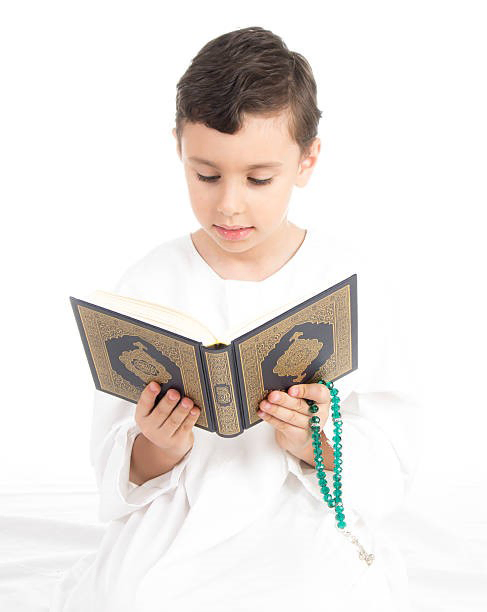
Qira’at: The Various Recitation Styles
Hafs An Asim
The Hafs An Asim recitation style is characterized by its clear and melodious sound, as well as its adherence to the rules of Tajwid (Tajweed), or the proper pronunciation and intonation of the Quranic text.
The recitation style is known for its precise and meticulous attention to detail, with each word and letter pronounced with utmost accuracy and clarity. This attention to detail is crucial in preserving the integrity and authenticity of the Quranic text, ensuring that it is recited in the same way it was revealed to Prophet Muhammad (peace be upon him).
One of the unique features of the Hafs An Asim recitation style is its use of Tarteel, a slow and measured recitation that allows for the listener to contemplate and reflect on the meaning of the verses.
This style of recitation is especially popular in mosques and Islamic gatherings, where the recitation of the Holy Quran is considered a means of spiritual enrichment and inspiration.
The melodious and rhythmic recitation of Quran in the Hafs An Asim style has a profound impact on the listener, evoking a sense of awe and reverence for the divine message contained within its verses.
The Hafs An Asim recitation style is also known for its memorization-friendly nature, making it easier for students of the Grand Quran to commit the text to memory. This is particularly important in Islamic tradition, where memorization of the Noble Quran is highly revered and considered a noble pursuit.
The clear and melodious recitation of the Pure Quran in the Hafs An Asim style helps facilitate the memorization process, allowing students to internalize the text and recite it with proficiency and accuracy.
Warsh An Nafi’
Warsh An Nafi’ is a recitation style of the Sacred Quran that is popular in North Africa, particularly in countries like Algeria and Morocco. It is one of the seven canonical ways of reciting the Glorious Quran, and is known for its unique pronunciation and melody.
This essay will explore the characteristics of Warsh An Nafi’ as a recitation style, and discuss its significance in the history of the Holy Quran.
One of the key features of Warsh An Nafi’ is its distinct pronunciation of certain letters and sounds. For example, the letter “qaf” is pronounced as a “g” sound in Warsh An Nafi’, rather than the more common “q” sound found in other recitation styles.
This gives the recitation a unique flavor and helps to distinguish it from other recitation styles.
Additionally, Warsh An Nafi’ is known for its melodious and rhythmic chanting, which is said to enhance the spiritual experience of reciting the Grand Quran.
Warsh An Nafi’ has a long and rich history, dating back to the time of the Prophet Muhammad.
According to tradition, the Prophet himself recited the Pure Quran in the Warsh An Nafi’ style, and this recitation was passed down through the generations by his companions.
Over time, different recitation styles emerged, each with its own unique characteristics and melodies. Warsh An Nafi’ eventually became one of the most popular recitation styles in North Africa, where it is still widely used today.
The significance of Warsh An Nafi’ lies in its preservation of Quran’s original pronunciation and melody.
By reciting the Holy Quran in the Warsh An Nafi’ style, Muslims are able to connect with the ancient tradition of Quranic recitation and experience the beauty and power of the words of Allah in a unique and profound way.
Additionally, the popularity of Warsh An Nafi’ in North Africa has helped to preserve and promote the recitation style, ensuring that it will continue to be passed down to future generations.
Al-Duri An Abu Amr
This style is named after its famous reciter, Abu Amr Al-Duri, who was known for his beautiful and eloquent recitation of the Glorious Quran.
The Al-Duri An Abu Amr style is characterized by its slow and deliberate pace, with each word pronounced clearly and distinctly.
One of the key features of the Al-Duri An Abu Amr style is its emphasis on the musicality of the Quranic verses. Reciters who follow this style carefully modulate their voice to create a melodious and harmonious sound that enhances the overall beauty and impact of the Quranic text.
The rhythmic patterns of the Al-Duri An Abu Amr style also add to the mesmerizing effect of the recitation, drawing listeners in and captivating their attention.
In addition to its musical qualities, the Al-Duri An Abu Amr style is also known for its adherence to the rules of Tajwid, the set of guidelines that govern proper pronunciation and articulation of Quranic verses.
Reciters who follow this style pay close attention to details such as elongation of vowels, proper enunciation of consonants, and correct placement of stops and pauses.
This dedication to precision and accuracy ensures that the Noble Quran is recited in the most authentic and faithful manner possible.
The Al-Duri An Abu Amr style is often favored by those who appreciate the artistry and beauty of Quranic recitation. Its slow and deliberate pace allows listeners to savor each word and phrase, reflecting on the meaning and significance of the verses.
The melodic tones and rhythmic patterns of this style create a soothing and meditative atmosphere that can be both spiritually uplifting and emotionally moving.
Famous Reciters and Their Styles
Sheikh Sudais
Sheikh Sudais hails from Saudi Arabia and is currently serving as the Imam and Khateeb (religious leader) of the Masjid al-Haram in Mecca, which is considered the holiest mosque in Islam.
He has been leading prayers at the mosque for over three decades, and his recitations have gained worldwide acclaim for their beauty and sincerity.
Sheikh Sudais is known for his unique style of recitation, which is characterized by its clarity, precision, and emotion. His voice is deep and resonant, with a commanding presence that effortlessly captures the attention of those listening.
He recites the Holy Quran with a perfect balance of Tajwid (the rules of Quranic recitation) and Maqamaat (melodic modes), which adds a musical quality to his recitations that touch the hearts of his audience.
One of the most striking features of Sheikh Sudais’s recitation is his ability to convey the meaning and spirit of the Glorious Quran through his voice.
Each word and verse is delivered with utmost care and reverence, as if he truly understands and feels the message of the Holy Quran. His recitations are not just a performance, but a heartfelt expression of devotion and worship that resonates with the souls of those who listen.
Sheikh Sudais’s recitations are also known for their emotional impact.
He often recites with tears streaming down his face, conveying the deep love and reverence he has for Quran and its teachings. This emotional intensity adds a depth and sincerity to his recitations that make them truly unforgettable.
In addition to his recitation skills, Sheikh Sudais is also a prolific Islamic scholar and preacher, known for his knowledge of Islamic jurisprudence and his eloquent sermons.
He uses his platform as an Imam and Khateeb to spread the message of Islam and promote unity and peace among Muslims.
Sheikh Mishary Rashid Alafasy
Sheikh Alafasy’s recitation style is known for its clarity, precision, and emotional depth.
He has a unique ability to evoke the true essence of the Quranic verses through his recitation, drawing listeners into a state of contemplation and reflection. His pronunciation of the Arabic text is flawless, making it easy for listeners to follow along and understand the meaning of the verses.
One of the key features of Sheikh Alafasy’s recitation style is his mastery of Tajwid (Tajweed), the rules of Quranic recitation.
Tajwid is essential for reciters to accurately pronounce the words of the Noble Quran, and Sheikh Alafasy’s command of these rules sets him apart as a reciter of exceptional skill and merit.
His precise articulation and intonation enhance the beauty and power of the Quranic verses, making his recitations a truly transformative experience for listeners.
Another striking aspect of Sheikh Alafasy’s recitation style is his ability to convey the emotions and reflections contained in the Quranic verses.
Through his melodious voice and heartfelt delivery, he brings the words of the Sacred Quran to life, imbuing them with a profound sense of spirituality and devotion.
His recitations resonate with listeners on a deep emotional level, evoking feelings of awe, reverence, and humility.
Sheikh Alafasy’s recitation style is characterized by its simplicity, sincerity, and humility. He approaches each recitation with a sense of reverence and dedication, treating the Grand Quran with the utmost respect and honor.
His humility and piety shine through in his recitations, creating a sense of intimacy and connection with the divine words of the Glorious Quran.
Sheikh Abdullah Basfar
Sheikh Abdullah Basfar is a renowned reciter of the Holy Quran who has gained widespread recognition for his melodious and powerful recitations.
His unique style and mesmerizing voice have captivated audiences around the world, making him one of the most sought-after reciters in the Muslim community.
Sheikh Abdullah Basfar was born in the city of Dammam, Saudi Arabia, and began memorizing Quran at a young age. He studied under various renowned scholars and memorized the Entire Quran by the age of 14.
His dedication to perfecting his recitation skills and mastering the complex rules of Tajwid (the proper pronunciation and intonation of the Sacred Quran) has earned him a reputation as one of the most skilled reciters of his generation.
One of the defining characteristics of Sheikh Abdullah Basfar’s recitation style is his clear and precise enunciation of each word and letter. He pays meticulous attention to pronunciation, ensuring that each letter is pronounced correctly and with the proper Tajwid (Tajweed) rules.
This attention to detail enhances the fluidity and beauty of his recitation, creating a mesmerizing and captivating listening experience for his audience.
Sheikh Abdullah Basfar’s recitation style is known for its emotional depth and heartfelt delivery.
He infuses each verse with passion and sincerity, conveying the profound meaning and significance of the Quranic verses through his emotional and soulful recitation.
His powerful and moving recitations have the ability to evoke strong emotions in listeners, allowing them to connect more deeply with the message and teachings of Quran.
In addition to his impeccable recitation skills, Sheikh Abdullah Basfar is also known for his humility and devotion to Quran. He approaches his recitations with a deep sense of reverence and respect for the holy text, understanding the immense responsibility that comes with the task of reciting the words of Allah.
His devotion to the Noble Quran is reflected in his commitment to perfecting his recitation and serving as a humble servant of Quran.
In conclusion the modes of Quran recitation of the Holy Quran are diverse and rich in tradition.
From Tajwid to Qira’at each mode offers a unique perspective on the recitation of the Pure Quran .
By following these modes Muslims can uphold the sanctity of Quranic text and deepen their spiritual connection to Allah.

